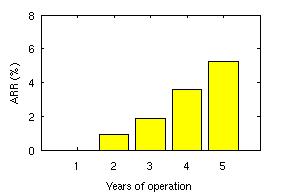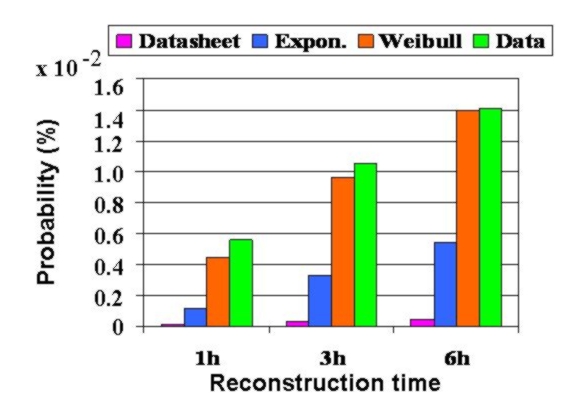Empirical system reliability
OverviewSystem reliability is a major challenge in system design. Unreliable systems are not only major source of user frustration, they are also expensive. Avoiding downtime and the cost of actual downtime make up more than 40% of the total cost of ownership for modern IT systems. Unfortunately, with the large component count in today's large-scale systems, failures are quickly becoming the norm rather than the exception. We believe that the key to building more reliable systems is to first better understand what makes system unreliable, i.e. what do failures in today's large-scale production systems look like. Although system reliability has been a key concern since the first computer systems were build 50 years ago, we know embarrassingly little about basic characteristics of failures in real systems. Much research, in industry as well as academia, is based on hypothetical and often simplistic assumptions, e.g. ``the time between failures is exponentially distributed'' and ``failures are independent''. The reason is that there is virtually no data on failures in real large-scale systems publicly available that could be used to derive more realistic models. The longterm goal of this project is to enable creation of more reliable systems through deeper understanding of real-world failures.
In our recent work, we have collected and analyzed failure data on node outages in a large number of HPC clusters
and data on storage failures in several large production systems.
Our initial analysis shows that many commonly used models and assumptions about failures are not realistic [FAST07, DSN06].
Below we first describe some of our recent results and then outline our longterm research plans.
Recent workUnderstanding failures in storage systemsAs part of this project, we have analyzed field-gathered disk replacement data from a number of large production systems, including high-performance computing sites and internet services sites. About 100,000 disks are covered by this data, some for an entire lifetime of five years. The data include drives with SCSI and FC, as well as SATA interfaces. The mean time to failure (MTTF) of those drives, as specified in their datasheets, ranges from 1,000,000 to 1,500,000 hours, suggesting a nominal annual failure rate of at most 0.88%. Below is a summary of a few of our results.
Understanding failures in high-performance computing systemsIn our recent work [DSN06] we analyze data on node outages in high-performance computing clusters. The data has been collected over the past 9 years at Los Alamos National Laboratory and includes 23000 failures recorded on more than 20 different systems, mostly large clusters of SMP and NUMA nodes. Our findings include for example that average failure rates differ wildly across systems, ranging from 20 to more than 700 failures per year, and that time between failures is modeled well by a Weibull distribution with decreasing hazard rate. From one system to another, mean repair time varies from less than an hour to more than a day, and repair times are well modeled by a lognormal distribution.
In a related thread of work [SciDAC07, CTWatch], we use the failure data for projections of failure rates of future petascale systems and how they will affect application effectiveness. We predict that if current technology and failure trends continue, the mean time to interrupt (MTTI) can be expected to drop dramatically over the next couple of years (see Figure 3 above). Assuming that fault tolerance is implemented by checkpoint-restart, this means that the largest applications will surrender large fractions of the system's resources to taking checkpoints and restarting from a checkpoint after an interruption, leading to greatly reduced application utilization ( see Figure 4 above). We also discuss coping strategies such as application-level checkpoint compression and system-level process-pairs fault-tolerance for supercomputing. Statistical properties of failure processesA significant part of our work focuses on the analysis of the statistical properties of failures, as recorded in our data. Better knowledge about the statistical properties of storage failure processes is not only necessary for a realistic reliability evaluation of new system designs (e.g. when creating synthetic failure workloads in simulations), but may also empower researchers and designers to develop new, more reliable and available systems. The most common assumption about the statistical characteristics of failures is that they form a Poisson process, which implies two key properties: exponentially distributed time between failures and independence of failures. We find in our analysis for both, disk failures and cluster node outages, that this assumptions is not very realistic. Below we provide some more detail on our results.
Longterm research agenda
Collecting failure dataOur plan is to collect detailed failure data from a diverse set of real, large-scale production systems that cover all aspects of system failures: software failures, hardware failures, failures due to operator error, network failures, and failures due to environmental problems (e.g. power outages). At this point, we have established relationships with more than a dozen large commercial sites and high-performance computing (HPC) sites, five of which have already contributed data. We are currently working with the Usenix Association to create a public failure data repository to host these data. A first draft of the repository can be viewed here .While collecting and sharing failure data might seem like a purely mechanical process, it turns out that it involves many research questions by itself. One question is, for example, how to efficiently and reliably sanitize and anonymize Gigabytes of free-form text data, such as trouble tickets. Several of these problems will require techniques from other areas. For example, We plan to investigate the use of methods from text analysis and document retrieval to help automate anonymization and analysis of free-form text data. Analyzing failure dataOur initial results indicate the strong need for new, more realistic failure models. We plan to identify and characterize the most relevant aspects of failure behavior in large IT systems with the goal of deriving accurate failure and repair models for a wide range of systems. Important aspects could, for example, include various statistical properties of the failure process, but also correlations between system parameters, such as workload, and the failure behavior. The results of this work will provide a more realistic basis for both experimental and analytical research on system reliability. While our initial results above are very recent, they are already being used by several researchers to parameterize their experiments and simulations.In our analysis we plan to use not only traditional statistical methods, but also to investigate techniques from data mining, which might be particularly useful in identifying relationships and correlations between various aspects of system behavior and observed failure modes. A key question will be how complex new failures models need to be. While highly complex models with a large number of parameters will provide a better fit to observed data, they not only pose a risk of overfitting, but will also be harder to use, since they are computationally and intuitively more complex. We are looking for the simplest models that still provide realistic results. Exploiting failure dataArmed with more realistic failure models, a natural next step will be to re-examine existing algorithms and techniques for fault-tolerant systems to understand where simpler (standard) models result in poor design choices and for those cases explore new algorithms. As one example, we revisit the old question of estimating the probability of losing data in a RAID system. We find that the probabilities derived with standard methods (assuming exponential time between failures and independent failures) can be two orders of magnitude lower than estimates derived from real data.
We also plan to investigate whether we can directly exploit some of the statistical properties of
failure behavior. For example, we find that the time between node outages in HPC clusters
exhibits decreasing hazard rates and am currently investigating how this
property can be used to design more efficient checkpoint protocols.
In the realm of storage systems, one could investigate whether statistical properties
of latent sector errors could be exploited to develop smarter scrubbing algorithms or
better algorithms for deciding when to replace a drive.
Another general questions is whether we can exploit correlations between past
system behavior and future failures for proactive fault management or for automated
diagnosis. An interesting avenue for future work would be to investigate the use of data mining and
machine learning techniques to solve some of these problems.
Publications
The work on this project has resulted in several publications, which are listed below.
In the media
This project has been featured in a number of online media reports: 28 February 2007 - eWeek.com 2 March 2007 - Computerworld 2 March 2007 - PC World 20 February 2007 - StorageMojo 20 February 2007 - Slashdot
AcknowledgementsWe would like to thank Gary Grider, Laura Davey and Jamez Nunez from the High Performance Computing Division at Los Alamos National Lab and Katie Vargo, J. Ray Scott and Robin Flaus from the Pittsburgh Supercomputing Center for collecting and providing us with data and helping us to interpret the data. We also thank the other people and organizations, who have provided us with data, but would like to remain unnamed. For discussions relating to the use of high end systems, we would like to thank Mark Seager and Dave Fox of the Lawrence Livermore National Lab. For questions and comments regarding this page, please contact Bianca Schroeder.
|






